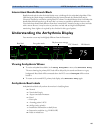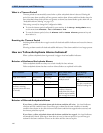
6 ECG, Arrhythmia, and ST Monitoring Arrhythmia Alarms
114
What is a Timeout Period?
Timeout periods are automatically started when a yellow arrhythmia alarm is detected. During this
period, the same alarm condition will not generate another alarm. Alarm conditions further down the
same arrhythmia alarm chain will also not generate an alarm, but alarms further up the chain will: see
“Arrhythmia Alarm Chaining” on page 115).
This setting can only be changed in Configuration Mode.
♦ To view the timeout period configured for your monitor, in the Setup Arrhythmia menu,
see the menu items TimeOut 1st and TimeOut 2nd.
♦ To reset the timeout period, select the Alarms Off or Pause Alarms permanent key and
then reselect it.
Resetting the Timeout Period
Switching alarms off and then on again cancels all visual and audible indicators and resets the timeout
periods.
Silencing an alarm cancels all visual and audible indicators, if the alarm condition is no longer present.
How are Yellow Arrhythmia Alarms Indicated?
When a yellow arrhythmia alarm is generated, it triggers visual and audible indicators.
Behavior of Unsilenced Arrhythmia Alarms
Yellow arrhythmia alarms are always set to latch visually for three minutes.
Yellow arrhythmia alarms that have not been silenced behave as explained in this table:
Behavior of Silenced Arrhythmia Alarms
If you silence a yellow arrhythmia alarm and the alarm condition still exists, the visual indicators
continue until the condition stops. You will not get a realarm for the same condition or another
condition lower down on the same chain until the alarm condition has stopped and reoccurred, and
the timeout period has expired.
If you silence a yellow arrhythmia alarm and the alarm condition has stopped, the visual indicators
are immediately cleared. Silencing an alarm does not reset its time out period, so you will not get a
realarm for the same condition or lower on the chain until the time out expires.
Alarm condition Example Configured time
out period
Short yellow alarm
tone sounds ...
Alarm message
displayed ...
Single alarm instance Non-sustained
V-tach
All settings when alarm condition is
initially detected
for 3 minutes (latching
time)
Continuous alarm condition HR LOW All settings until the alarm condition
stops, plus a maximum of
3 minutes latching time
Same intermittent alarm
condition, occurring
frequently (more than once
per minute)
Pair of PVCs 2 minutes or less
3 minutes or more each time the alarm
condition is detected,
provided that the timeout
period has expired and the
alarm message has cleared


















